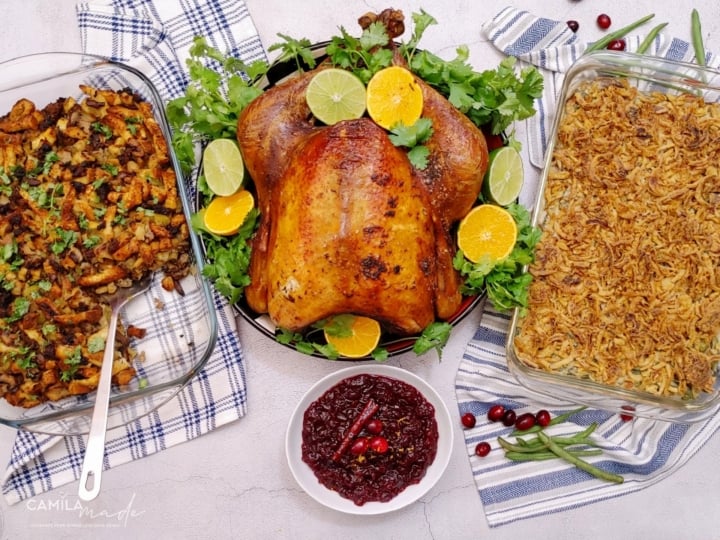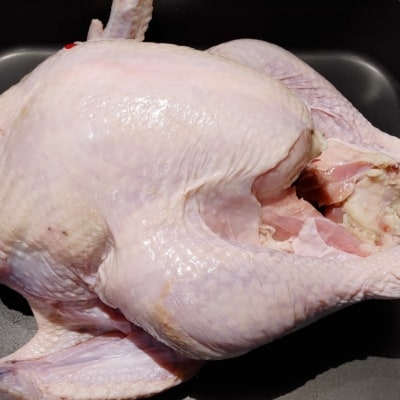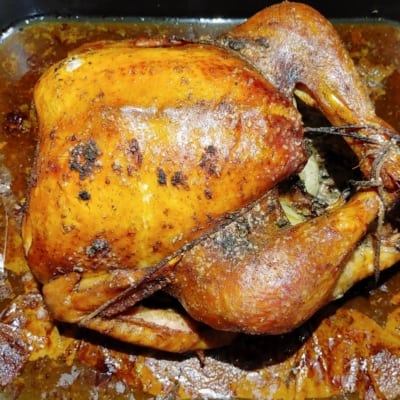The long-awaited Thanksgiving turkey is so flavorful that it shouldn't be reserved for November alone. Bring this dry-brined turkey with Gravy recipe to your table
throughout the year and savor the tender, succulent meat of this magnificent bird. Don't forget to round out your meal with Thanksgiving favorite sides, such as
Homemade Cranberry Sauce, Green Bean Casserole, Sausage Cornbread Stuffing, Sweet Potato Casserole with Pecan Streusel and Cornbread.🍁🦃🍽️
How to Make Dry Brined Turkey
Note: The full instructions are provided in the recipe card below.
- Brine the turkey and refrigerate.
- Allow the turkey to come to room temperature.
- Preheat the oven to 350°F.
- Prepare the butter mixture, clean the turkey of brine, and stuff it.
- Roast the turkey for approximately 2½ hours or until the internal temperature reaches 165°F.
- Let the turkey rest for 20 minutes.
- Prepare the gravy.
Tips and Advice
- When making gravy, add salt gradually since the saltiness of turkey drippings can vary. Taste as you go to ensure the flavor is just right.
- If you're using frozen turkey, remember you'll need 24 hours' thawing time in the refrigerator for every five pounds.
See More Holidays Recipes:
- Sweet Potato Casserole with Marshmallows
- Spoonbread
- Crispy Roasted Potatoes
- Roasted Sweet Potatoes with Honey and Cinnamon
- Sausage Cornbread Stuffing,
- Sweet Potato Casserole with Pecan Streusel
📖 Recipe
Easy Dry Brined Turkey
Ingredients
For The Dry Brined:
- (1) 12 to 14 Pounds fresh or frozen whole turkey, thawed. Giblets and neck removed; bird rinsed, patted dry, and at room temperature
- 3 tablespoons Kosher salt
- 1 tablespoon ground black pepper
- 2 teaspoons granulated garlic
- 2 teaspoons granulated onion
- ¼ cup light or brown sugar
- 1 tablespoon dried sage
- 1 tablespoon dried thyme
- 1 tablespoon dried rosemary
- 1 tablespoon regular or smoked paprika
- 1 large bunch of fresh thyme
- grated zest from 2 lemons (reserve the lemons for later use; quartered)
- grated zest from 1 orange
For the Brushing:
- 6 tablespoons unsalted butter , melted
- 1 teaspoon fresh thyme leaves, chopped or dried thyme
- 1 fresh lemon , zested and juiced
For the Vegetables:
- 1 large large sweet onion or yellow onion , peeled and quartered
- 2 large carrots , peeled and cut into 2-inch chunks
- 2 large stalks celery , cut into 2-inch pieces
- 1 head garlic , halved crosswise
- 1 lemon , quartered
For the Gravy:
- 1 stick unsalted butter
- 1 medium sweet or yellow onion , finely chopped
- ¼ cup all-purpose flour
- 2 cups water
- ½ cup hot defatted turkey dripping
- 2 tablespoons White wine, cognac or brandy
- 1 tablespoon heavy cream , optional
- 1 tablespoon chopped fresh herbs (such as thyme, sage, or rosemary)
- ½ teaspoon ground black pepper , or to taste
- ¼ teaspoon Knorr Chicken bouillon or kosher salt , adjust to taste
Instructions
Preparation of the Turkey:
- Start by removing and discarding the truss from the turkey legs. If the legs are held together by the skin, cut the skin to release them.
- Take out the giblets and neck from the turkey. You can either discard them or save them for making stock.
- Rinse the turkey inside and out. Remove any excess fat and leftover pinfeathers. Pat the turkey dry with paper towels.
- Place the turkey on a rimmed baking sheet lined with a wire rack.
Making the Dry Brine:
- In a small bowl, mix together brown sugar, kosher salt, thyme, rosemary, granulated garlic, granulated onion, sage, paprika, lemon zest, orange zest, and pepper.
- Rub the dry brine mixture over the entire surface of the turkey, including the cavity.
- Let the turkey refrigerate for 12 hours to 2 days, covered loosely with plastic wrap or foil.
Roasting the Turkey:
- Uncover the turkey and let it sit at room temperature for 1 hour before roasting.
- Preheat the oven to 350 degrees Fahrenheit.
- Melt butter in a saucepan, then mix in the zest and juice of 1 lemon and 1 teaspoon of freshly chopped thyme leaves. Set aside.
- Brush off the dry brine from the turkey using damp paper towels.
- Stuff the turkey's cavity with a bunch of fresh thyme, halved lemon, and quartered garlic. Then, place chopped onion, carrots, and celery in the bottom of a roasting pan.
- Place the turkey on a roasting rack inside the pan. Tie the legs together loosely and tuck the wingtips under the body. Brush the butter mixture all over the turkey.
- Roast the turkey for approximately 2½ hours, basting occasionally with pan juices. The turkey is done when the internal temperature reaches 165°F in the thickest parts. If the skin browns too much, cover it loosely with foil.
- Once roasted, transfer the turkey to a cutting board, cover with foil, and let it rest for 20 minutes.
Making the Gravy:
- In a medium saucepan, melt butter over medium-low heat. Cook onions until lightly browned, about 15 minutes.
- Sprinkle flour into the pan and cook for 2-3 minutes, stirring continuously to eliminate raw flour taste.
- Pour in white wine, cognac, or brandy and cook for 2 minutes to evaporate alcohol.
- Slowly pour in hot defatted turkey drippings and water while whisking to prevent lumps. Add Knorr Chicken Bouillon and pepper. Bring to a boil, then simmer until thickened, about 5 minutes, stirring occasionally.
- Finish with Herbs and Cream: Stir in herbs and cream. Taste and adjust seasoning with more Knorr Chicken Bouillon or salt and pepper as needed.
Notes
- Leftover turkey can be stored in an airtight container in the refrigerator for up to three days. To reheat, place it in a preheated 325°F oven for 20-30 minutes or microwave to heated through.
- For the gravy, store it in an airtight container in the refrigerator for up to three days. Reheat it in a heavy-bottomed pot over medium heat, stirring frequently. Adjust the consistency by gradually whisking in up to one cup of additional liquid (drippings, stock, or broth) until it reaches your desired thickness.
- The turkey can be roasted and carved two days in advance. However, you will lose the crispy skin. Here's how: Pour a thin layer of the gravy into an ovenproof serving dish. Arrange the carved turkey on top of the gravy,
cover it tightly with plastic wrap, and refrigerate for up to two days. Refrigerate the remaining gravy in a separate container. - Freezing is not recommended.
All nutritional information is based on third-party calculations and is only an estimate. Each recipe and nutritional value will vary depending on the brands you use, measuring methods, and portion sizes per household.











